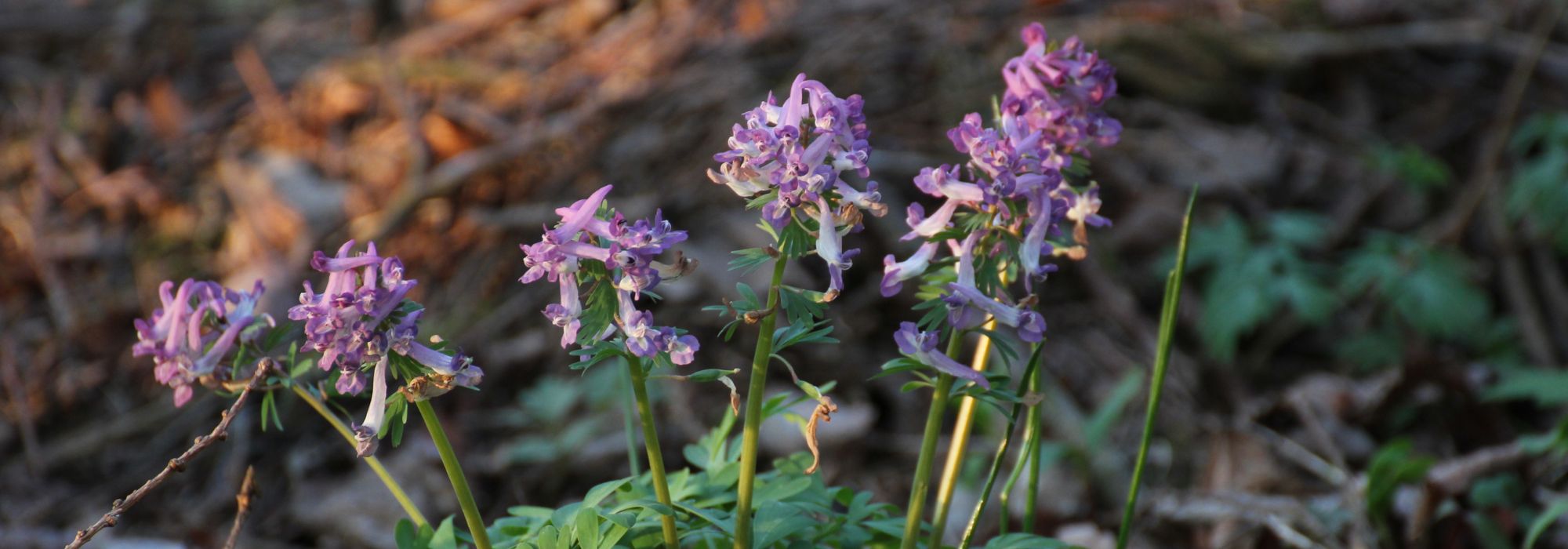
Corydalis bulbous : planting, growing, and care
Contents
Bulbous Corydalis in a few words
- This is a charming little bulbous perennial plant
- It displays a delicate spring flowering with tubular white, pink, or purple flowers
- It boasts beautiful tender green or glaucous cut foliage
- Easy to grow and highly cold-resistant, it thrives in partial shade or non-scorching sun, in well-drained soil that remains moist
- It is perfect for woodland gardens and shaded rockeries
The word from our expert
The bulbous Corydalis, or solid Corydalis (Corydalis solida), is a charming little tuberous perennial plant that offers a spring flowering of curiously spurred tubular flowers. Often pink in the case of Corydalis solida ‘Beth Evan’ or purple-violet in Corydalis solida ‘Purple Bird’, sometimes white, they emerge like so many little birds from a delicate fern-like foliage that disappears in summer.
It is also called the solid-tubered Corydalis, in contrast to Corydalis cava, the hollow-tubered Corydalis, to which it is very closely related.
Hardy and easy to grow, it is rarely affected by diseases and thrives with minimal care. The bulbous Corydalis is a partial-shade plant that thrives in any well-drained garden soil that remains slightly moist.
This woodland host also finds its place equally well under large trees or in shaded rockeries.
Discover this beautiful, nearly foolproof perennial spring bulb!
Description and Botany
Botanical data
- Latin name Corydalis solida
- Family Papaveraceae
- Common name Solid corydalis, solid-tubered corydalis
- Flowering March to April
- Height 0.15 to 0.20 cm
- Exposure Partial shade, shade
- Soil type Light, fresh, well-drained
- Hardiness -15 °C and beyond
The tuberous corydalis or bulbous corydalis is a perennial plant from the Papaveraceae family (formerly Fumariaceae), like the poppy or Bleeding Heart (Dicentra). Corydalis are very close to fumitories, and were previously classified under the Fumariaceae family. The genus Corydalis includes over 500 species. They are native to temperate regions of the Northern Hemisphere, northern Europe and Asia, mainly China. In their natural habitat, these plants grow primarily in forests, fresh undergrowth, shaded and humid environments, and often in montane meadows.
Some Corydalis have changed families, such as the Solid Corydalis (Corydalis solida) or solid-tubered corydalis. This species has naturalised in France. We distinguish Corydalis solida, which grows from a bulb or more precisely a tuber, from Corydalis flexuosa, which are herbaceous plants spreading via stolons. It is sometimes confused with common fumitory or hollow corydalis, Corydalis cava, to which it is very similar.
This small tuberous perennial plant develops into a bushy clump from a single tuberised root. Its bulb contains nutrient reserves and has no space between its layers, hence its names “solida” and “solid-tubered corydalis”. At maturity, it reaches 15 to 20 cm in height and 20 to 25 cm in spread.
Finely and deeply incised, with a light appearance, the foliage resembles that of maidenhair fern or columbine. The deciduous aerial vegetation disappears completely in winter. In spring, stems with finely divided, petiolate, and compound leaves emerge from the soil. They are alternate, divided into 3 narrow and ovate segments. They measure 5 to 8 cm long and display beautiful shades of green, ranging from light grey-green to bluish-green.
On this lush and finely divided nest of greenery, flowering occurs towards the end of spring, from March to May. The upright flower spikes bear clusters of 10 to 20 compact, hermaphroditic flowers at their tips, standing above the foliage. The flowers have a slender, elongated, tubular shape, 1 to 2 cm long. They are composed of four fused petals, with the lower one featuring a long, slender spur reflexed backwards. This crest-like feature is said to have given the plant its vernacular name, “Korydallis” in Greek meaning “crested lark”. The corydalis resembles a bush populated with birds. The tube opens into a two-lipped mouth with a white throat adorned with stamens. Digitate bracts, divided into strips, encircle each flower.
The Solid Corydalis bears a delicate rose-purple, purple-violet flowering in Corydalis solida ‘Purple Bird’, or diaphanous white in ‘White Swallow’, which stands out beautifully against the green foliage, earning it the very poetic English nickname ‘White Swallow’.

Corydalis solida ‘Purple Bird’, ‘White Swallow’ and ‘Beth Evans’
After pollination by insects, these inflorescences give way to elongated capsules, measuring up to 2.5 cm long, containing black seeds. The plant tends to self-seed without ever becoming invasive.
When summer arrives, with the first heat, the foliage wilts and yellows, and the plant goes dormant to protect itself from drought, leaving the bulb dormant underground. It will reappear the following spring.
Main varieties

Corydalis solida
- Flowering time April, May
- Height at maturity 15 cm
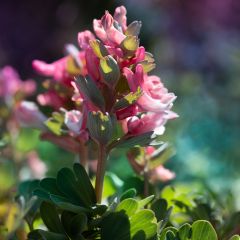
Corydalis solida Beth Evans
- Flowering time April, May
- Height at maturity 15 cm

Corydalis solida Purple Bird
- Flowering time April, May
- Height at maturity 20 cm
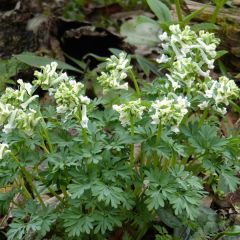
Corydalis solida White Swallow
- Flowering time April, May
- Height at maturity 20 cm
Discover other Tuberous Corydalis
View all →Available in 1 sizes
Available in 1 sizes
Available in 1 sizes
Available in 1 sizes
Available in 1 sizes
Available in 1 sizes
Planting the bulbous Corydalis
Where to Plant It?
Very hardy down to -23.5°C, the bulbous Corydalis can be grown without difficulty in most of our regions. This small tuberous plant is a perennial of fresh woodlands, appreciating partial shade, or even full shade, or light sun. It dislikes overly hot and scorching exposures and grows easily under deciduous trees, whose root competition it does not fear. It requires very well-draining and moderately fertile soil, remaining fresh in spring. It will tolerate a sunny exposure (except in the South) if the soil remains sufficiently moist and cool in summer. Accommodating, it tolerates the presence of lime and clay in the soil. It dislikes summer drought, nor excess water in winter, which could cause the bulb to rot.
In the garden, however, avoid planting in large groups, as once summer arrives, the bulbous corydalis often disappears, leaving an unsightly gap in flower beds.
The bulbous corydalis is ideal for dressing up shaded areas, such as woodland edges or cool rockeries. It will also thrive in a perennial bed or border, atop walls in partial shade. This plant also performs very well in pots.
When to Plant the Bulbous Corydalis?
Planting the bulbs of Corydalis solida is preferably done in autumn from September to November, outside periods of frost and drought. They will have more time to establish. They can also be planted in February if necessary.
How to Plant It?
The bulbs of the bulbous Corydalis are prone to drying out and rotting when out of the soil, so they should be planted without delay after purchase.
In the Ground
Plant approximately 15 bulbs per m² in perfectly drained soil.
- Loosen the soil
- Dig a hole using a dibber and spread a handful of gravel or pozzolana about two centimetres beneath the bulbs
- Plant at about three times the height of the bulb, spacing them about 20 cm apart, ensuring they do not touch
- In heavy soil, improve drainage with gravel or pozzolana
- Cover the bulbs with soil mixed with good compost
- Water generously
- Remember to mark the presence of the bulbs with a label or small stake to avoid forgetting them during their dormancy
In Pots
The bulbous Corydalis is easily grown in pots to enjoy its lovely early spring flowering on the terrace or balcony.
- Spread a layer of clay pebbles at the bottom of a perforated pot or planter
- Fill with a light, well-draining mixture of compost and gravel or pozzolana
- Plant the bulbs, covering them with three times their height in soil
- Water once a week during the growing season, then stop watering in summer during the rest period when the foliage begins to yellow
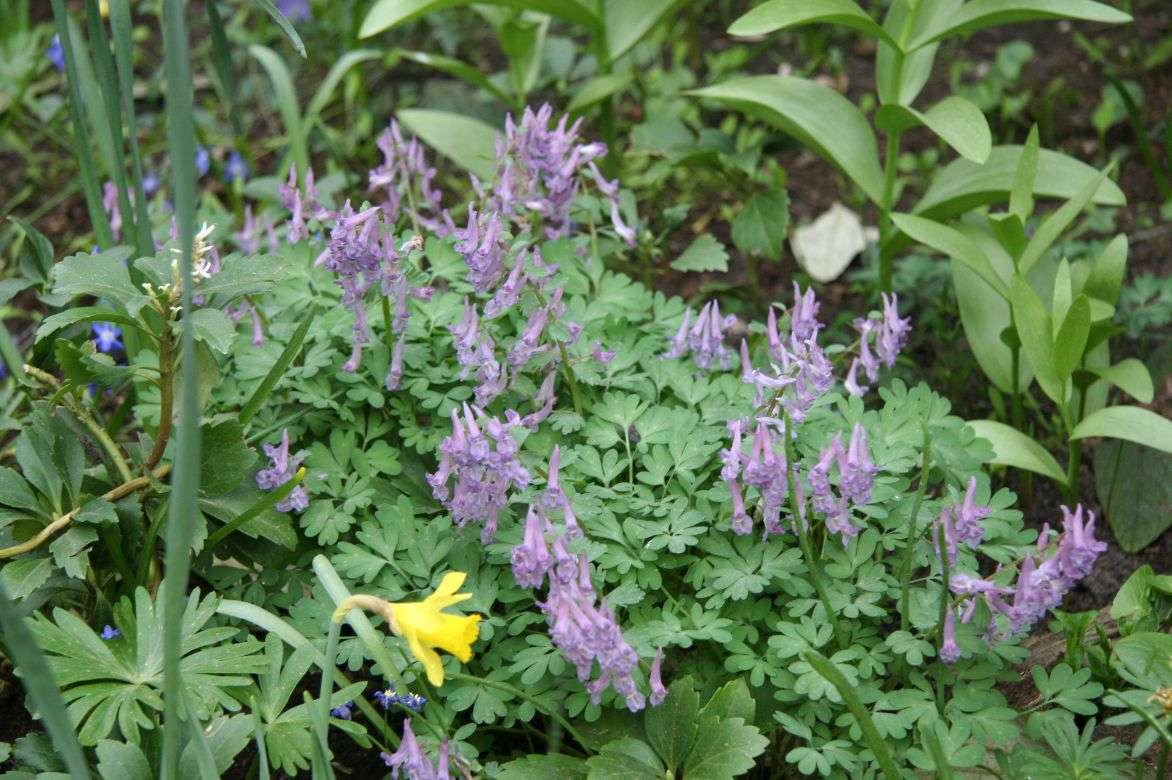
Corydalis solida
Growing and carinf of the Bulbous Corydalis
Corydalis solida requires little maintenance. In summer, the soil should remain cool: ensure regular watering, especially during dry and hot weather. You can apply a mulch such as flax mulch or ramial chipped wood (RCW) at the base to retain moisture. Stop watering during the summer dormancy period.
At the very beginning of spring before flowering, spread some well-decomposed compost around your corydalis to enrich the soil.
During the flowering period, remove faded flowers as they appear to encourage the emergence of new flowers.
Only cut back the foliage to ground level once it has completely withered, allowing the bulb time to replenish its reserves.
This corydalis is rarely affected by diseases and pests in well-drained soil. Excess moisture can cause bulb rot. However, gastropods may feast on the young foliage in spring. A slug treatment from February onwards is essential. Follow our advice to protect it from the appetite of slugs and snails. The solid-tubered corydalis can be affected by downy mildew and rust, especially during prolonged dry spells.
Multiplication
The bulbous corydalis tends to self-seed spontaneously. To obtain new young plants, you can collect the seeds from the current year and sow them in autumn. Give them a few days of stratification in the refrigerator. Sow on the surface of a special sowing compost mixed with sand. Water with a fine spray. Place the pots in a bright spot but sheltered from direct sunlight at 15°C and keep the substrate moist. Be patient, germination can sometimes take a while. Transplant into the garden when the seedlings reach 5 cm in height.
Associate
Since the Corydalis solida is not bothered by competition from tree or bush roots, in a woodland garden, it can be planted under deciduous trees alongside ferns, such as Dryopteris or Polystichum with finely cut foliage, brunneras, Solomon’s seals, and a carpet of periwinkles. The bright blooms of Dicentra spectabilis and epimediums will make excellent companions.
In a partially shaded rock garden, it will thrive alongside the Geranium nodosum, heucheras, purple creeping bugle, and campanulas.
It will also be perfect near a water feature and at the base of marginal aquatic plants, such as rodgersias, hostas, ligularias, goat’s beards, and other astilbes that enjoy similar conditions.
It will beautifully accompany a host of spring bulbs like hyacinths, Fritillaria bulbs (Fritillaria meleagris), chionodoxa, cyclamens, ipheions, scillas, or even botanical tulips.
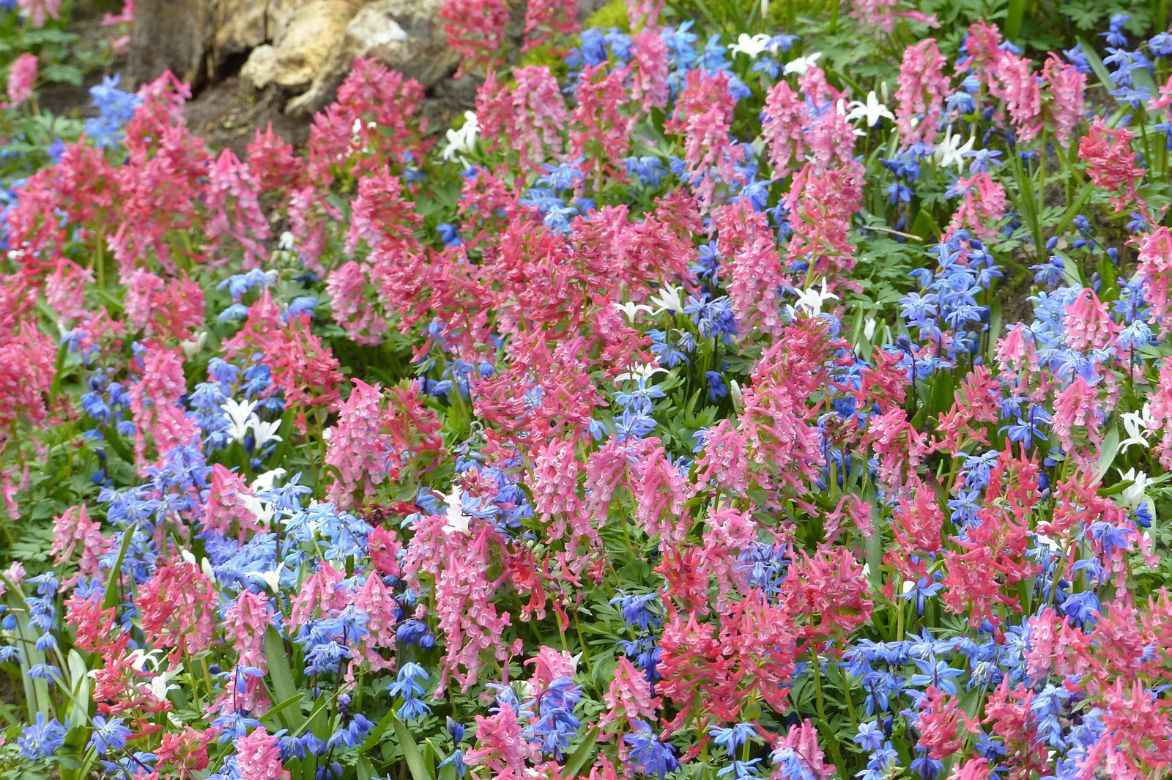
Corydalis solida ‘Beth Evans’ in good company with Chionodoxa lucilliae ‘Alba’ and Scilla sibirica
Useful resources
- Discover our guide on pairing the bulbous Corydalis
- What to plant under my trees?
- What are the best plants for woodland gardens ?
- Subscribe!
- Contents































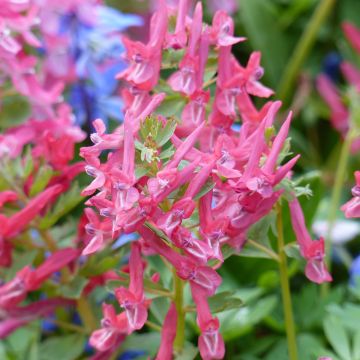

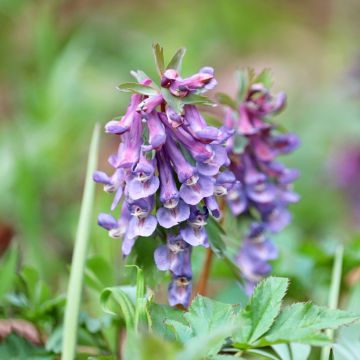



Comments